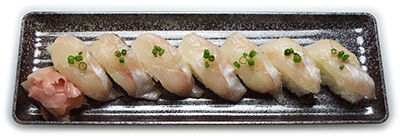| Please access the following URL if you want to secure using SSL. All pages in the site will be secure pages. |
https://secure02.blue.shared-server.net/www.fish-food.co.jp/message english 12.2022.html |
Welcome to FISH FOOD TIMES
Dec. 2022 issue No.228

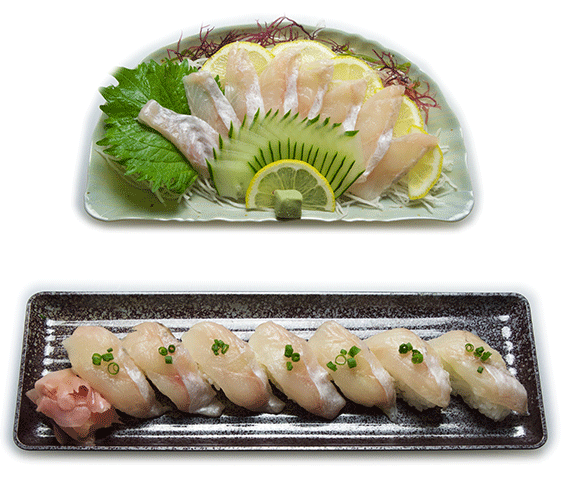
Sailfin poacher sashimi and sushi
I was surprised by the strange shape

The author is over 70 years old, has worked as a fresh fish consultant for over 30 years, and has also been involved with fish during his time as a company employee, so in total, I have been working with fish for about 50 years. Therefore, I have come into contact with many different kinds of fish compared to the average person.
However, although I was born in Fukuoka Prefecture and lived in Tokyo for about 7 years when I was around 20 years old, I have lived in Fukuoka Prefecture ever since. From this, it cannot be denied that there is, in a sense, a regional bias. Therefore, regarding fish, it can be said that although it is relatively strong in fish from Kyushu to western Japan and southern Japan, it has weaknesses in the knowledge and experience of fish in areas from eastern Japan to the north.
Actually, the sailfin poacher in this image had never been seen or even touched, let alone eaten, until I became a fresh fish consultant. When I saw this fish for the first time, my impression was "What is this... an alien..." I remembers being terrified to even touch the fish.
As for its visual characteristics, first of all, it has a long snout (the part from the tip of the mouth to the front edge of the eye), fluttering tip of the nose, and large raised black eyes. In particular, I wonder what the fluttering tip of the long snout exists for. It doesn't look like a monkfish lantern, and it might be a tactile organ.
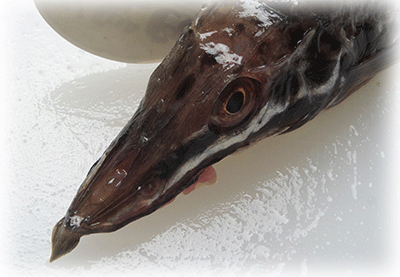
And the unusually large eyeballs in proportion to the head have a menacing presence.
ts mouth is also strange.
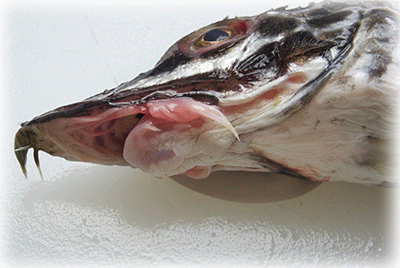
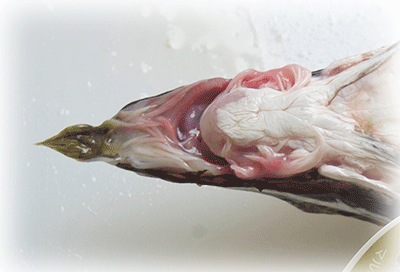
If you look closely at the mouth, you can see that there are many whisker-like organs lined up. It has an extreme overhanging upper jaw, a smaller lower jaw, and no sharp teeth visible from the outside. It can be inferred that the shape of this mouth is convenient for preying on benthic organisms on the bottom of the sea, and that the whisker-like organs are suitable for searching for prey as a sense of touch. Even so, the reddish, glossy color of the lips, as you can see in this image, also makes me feel creepy.
Next is the surface of the fish body
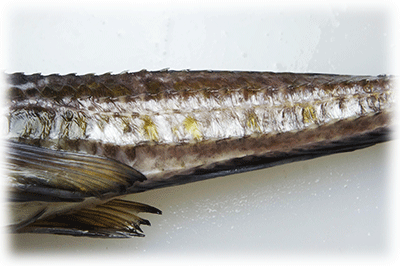
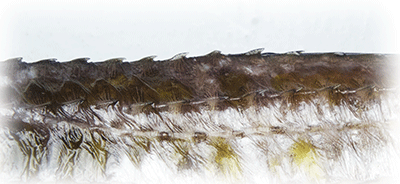
The surface of the sailfin poacher is hard, and there are countless sharp and hard thorns, and they are lined up in a total of 8 rows, 4 rows on the left and right, just like a warrior wearing armor. It seems that this is the shape of a horse mackerel's scute, the scales of which have been transformed into this shape. In general, scales arranged in a row on the lateral line that runs horizontally in the middle of the fish body are called lateral line scales, and the number of scales is an important key to the classification of fish.
This row of spines forms an octagonal body that is another characteristic of the sailfin poacher. Due to this shape, it is also called hatsukaku in Hokkaido and elsewhere.

And after all, what characterizes the sailfin poacher like a sailfin poacher is the dorsal and anal fins.
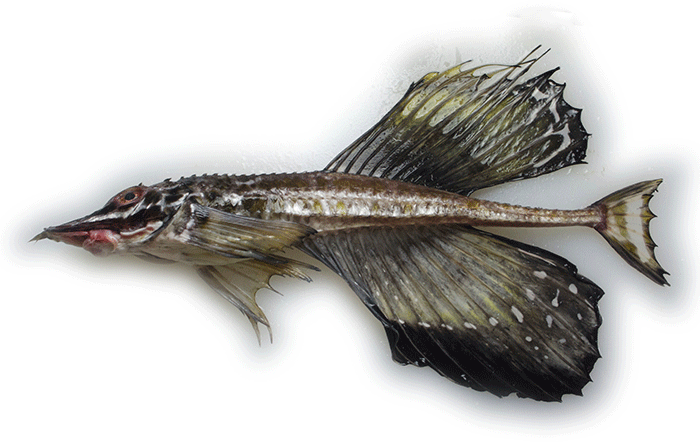
The dorsal and anal fins are extremely large like the wings of a butterfly, and the Japanese name Tokubile comes from the fact that the fish has a "specially large fin".
Speaking of fish with particularly large fins, there is a bluefin sea robin that you all know well.
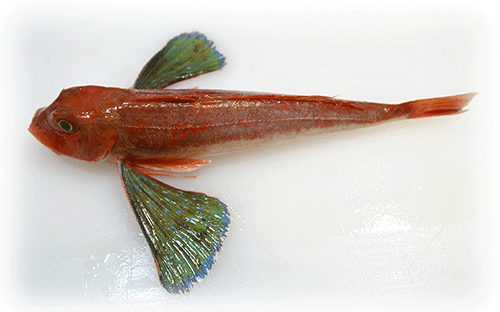
As you can see from this image, the bluefin sea robin has large pectoral fins and is completely different from the sailfin poacher. The overall color of bluefin sea robin is vivid, and when it is made into a product, it looks like the figure sashimi in the image below (FISH FOOD TIIMES No.206 bluefin sea robin figure sashimi, February 2021 issue). However, sailfin poacher doesn't want to be a figure sashimi for its appearance.
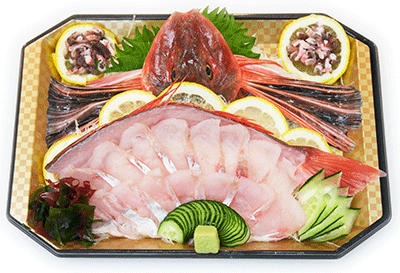
There are still many unknowns in the world of fish
The sailfin poacher belongs to the suborder Scorpanieforme, family Agonidae, genus Podothecus, and the bluefin sea robin belongs to the suborder Scorpionidae, family Trigidae, genus Chelidonichithes. Although it has a vertical flattened shape that looks like it has been crushed from above, basically it should be seen as a different species of fish rather than a closely related species.

The shape of fish is flattened in the dorsal and ventral direction, such as sailfin poacher and bluefin sea robin, and there is a vertical flat type that is suitable for living on the bottom. In addition, skipjack and yellowtail have a thick central part to reduce water resistance while swimming, and there is a spindle shape that gradually tapers toward the head and tail ends. There is also a laterally flattened body shape that is effective in preventing feeding damage from predators by contacting the cracks of rocks and the seabed. And there are elongated types that are convenient for infiltrating into narrow holes on the bottom of the water, such as eels and pike congers. These are the four representative basic forms. 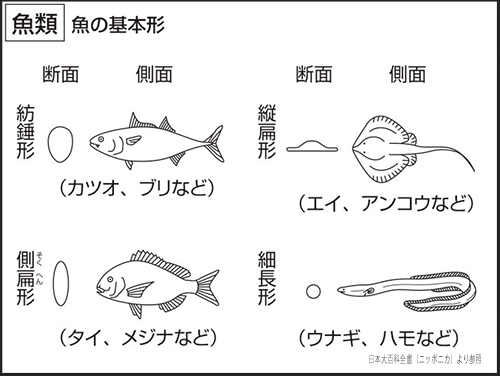
In this way, fishes can be broadly classified into four types, but scientifically speaking, the name "fishes" is just a convenient way to refer to fish that swim in the sea or rivers.
The ocean, which accounts for 70% of the earth, still has many unknown parts, and there are many unknown things and undiscovered species. Currently, the classification of fish as "genus" and "order" is only provisional and may change significantly in the future.
Fishes were once divided into Pisces and Gnathostomata, placed under the "vertebrate phylum". These were further differentiated by the presence or absence of jaws: jawless gnathostomes and jawed gnathostomes.
Although it is currently difficult to classify them strictly as "fishes," they can be roughly classified as gnathostomes according to the characteristics of the species. The gnathostomes are divided into bony fishes and cartilaginous fishes.
Teleosts are fishes literally composed of hard bones, and the bones of each part, including the skull, are composed of small bones joined together, and it is widely believed that there are more than 26,000 species. This bony fish is further classified into Actinopterygii and Sarcopterygii.
Most Osteichthyes belong to Actinopterygii and are characterized by bundles of bones radiating from the pectoral fins and connected to the scapula. Salmon, eel, flying fish, pufferfish, anglerfish, and carp, which are generally called "fish", belong to Actinopterygii. Next, Sarcopterygii had pectoral fins connected to the scapula by a pair of bones. It has a bone structure similar to that of "tetrapods" like humans and animals, and it is generally believed that tetrapods evolved from Sarcopterygii, which includes coelacanths and lungfish relatives.
Next are cartilaginous fish, these are fish made up of soft, elastic bones (cartilage). It is considered to be a more primitive species than bony fishes, and is characterized by having multiple pairs of gill holes, replacing teeth, and lacking a swim bladder. Typical of these fish are rays and sharks. It is said that there are more than 500 species of rays and more than 500 species of sharks in both freshwater and seawater.
And finally Agnatha. As the name suggests, this fish has no jaws. Hagfish, lampreys, etc. are such species, but they are distinct from the commonly recognized eels. Since this species has no jaws, it cannot chew, and when it eats, it clings to its opponent and sucks flesh and body fluids from its mouth. Recent studies have hypothesized that these organisms share the same characteristics as the ancestors of all vertebrates.
Now, it is not easy to systematically explain the above in words scientifically. However, the figure below is a document published by the Laboratory of Evolutionary Biology, Faculty of Science and Technology, Sophia University, and if you look at it, you will be able to organize and understand it a little.
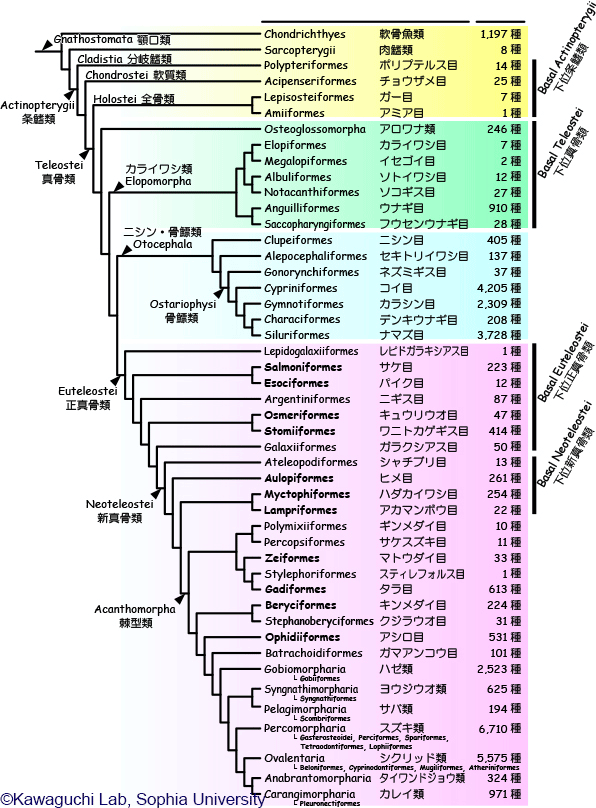
According to Sophia University's overview, fish are a diverse group that makes up half of the vertebrates. Since the phylogenetic relationships are complicated, the university applied the classification and phylogeny to the familiar periodic table of the elements, and devised this in an attempt to make the diversity as familiar as possible. It is called the ``Fish Periodic Table'', and the top left of this table shows fishes with old divergence, and the bottom right shows fishes with new divergence.
Research on mammals and birds is already quite advanced, and new species are very rarely discovered. However, dozens to hundreds of new species of fish are discovered every year, and new discoveries sometimes overturn conventional wisdom, making the classification of fish extremely fluid. In recent years, it has become possible to check the similarity and commonality of species at the genetic level through DNA testing, so it has become possible to discover that unexpected species are connected or not connected at all.
The figure below is from the website of the Sunshine Aquarium. According to this expression, fishes is "used only for convenience as a collective name for fish-like things".
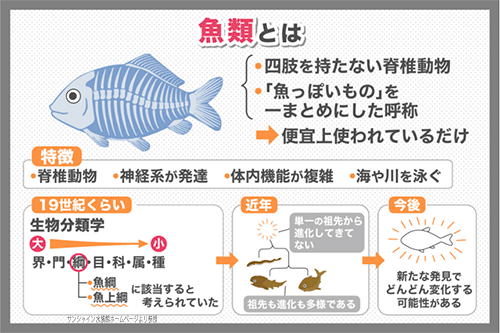
Come to think of it, is there any other world that is as profound in terms of natural biology? Since dozens to hundreds of new species of fish are found every year, I wonder where and how much scale they will eventually reach.
I'm not a fish researcher, but I've been working with fish for a long time, so I'm proud to say that I have a little more knowledge of fish than the average person. However, the more I know about the world of fish, the more I realize that my level of knowledge about fish is nothing more than "flea droppings."
Since the author has written articles for TIMES focusing on "fish for human consumption (FISH FOR FOOD)", the target fish species are limited. However, even in such a limited world, we will be dealing with alien-like fish like this month's issue, and the world of fish is really vast, and we can't help but feel the depth and depth.
The deliciousness of aliens is a different dimension
Now let's get back to the aliens. The author feels that the shape of sailfin poacher is of a different dimension, but I think that the taste is also a different dimension. Unfortunately, I have never dealt with sailfin poacher females, but according to information, the dorsal and anal fins are not as big as the males, and the fish is small and has no fat, so it is traded at a different price than the males. It means that In other words, the deliciousness of a different dimension is the male, and I can't comment on the female because I don't know.
Below, I will introduce the process of making sailfin poacher males into sashimi and sushi.
| sailfin poacher sashimi and sushi | |
|---|---|
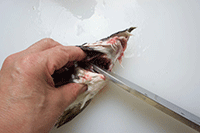 |
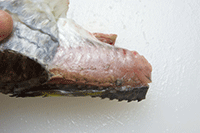 |
| 1,Cut off the jaw root. | 8,Grasp the skin on the head side with your fingers and pull it toward the tail side to peel off the skin. |
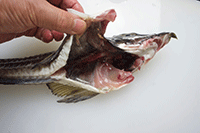 |
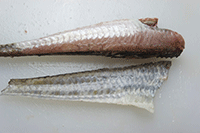 |
| 2,Open the abdomen vertically and remove the internal organs. | 9,The state where the skin on the upper body side has been removed. |
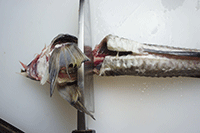 |
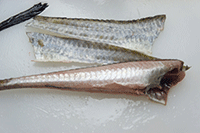 |
| 3,Cut off the head. | 10,The skin on the lower body side is also peeled off. This skin is said to be delicious when fried, but I didn't feel like cooking it. |
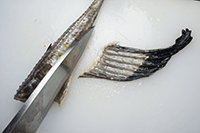 |
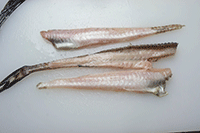 |
| 4,Cut off the wide and large anal fin. | 11,Perform three pieces disassembling with the technique of daimyou disassembling. |
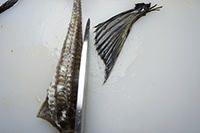 |
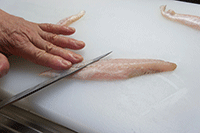 |
| 5,Similarly, cut off the large dorsal fin. | 12,With the skin side down, cut in using the technique of sogitsukuri sashimi. |
 |
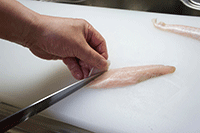 |
| 6,When cutting the pelvic fin, make a shallow cut with the edge of the knife. | 13,One step before separating the skin side, raise the mine of the knife at a right angle and attach the kirikado. |
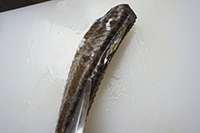 |
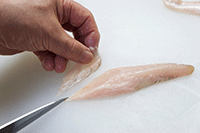 |
| 7,Make a shallow cut on the edge of the dorsal fin in the same way with the tip of the knife. | 14,Finally, after separating the sashimi, turn it over and place it on the sashimi plate, these are also used for the sushidane. |
.gif) |
|
|
|
Contrary to its strange appearance, the sailfin poacher has firm white meat that is elastic, does not easily collapse, and is easy to cut with a kitchen knife. When you bite into it, you can feel the slightly well-balanced fat, which gives it an elegant flavor. In this month's issue, I described the sailfin poacher as an alien, so if I were to use a word like that, I would describe it as "another dimension of deliciousness." I would like to leave it to each reader's imagination how to capture the deliciousness of another dimension.
Unknown fish and domestic fisheries
The sailfin poacher is said to be the fattest and most delicious of the year during the three cold winter months from December to February. However, because it is a fish with such good quality fat, it is said that it is delicious as it is even if it is out of season. On the other hand, this fish has strong regional characteristics, and apart from the Tohoku and northern regions, it is thought that it is not easy to sell in other regions.
Among the fish around Hokkaido where sailfin poacher is caught, there are still many fish that have not been picked up by FISH FOOD TIMES. However, as I mentioned at the beginning, my knowledge of the fish that live in the north is weak, and in fact, I often do not know the name of the fish even if I see them.
For example, here is an image of a fish with the same vertical flattened shape as the sailfin poacher below, which I took a picture of and handled by myself.The fish above is said to be a sculpin, but I am not sure what kind of sculpin it is. I'm guessing it's Snowy sculpin, but I don't know where to judge the difference.


And the bottom image above is also a picture I took myself, but this fish is called a greenling, and the shape is slightly different from the greenling I have known for a long time, causing confusion in knowledge. In fact, it seems that this is also a type called Ezo greenling, which is common in Hokkaido.
I would like to take up these two fish as the theme of FISH FOOD TIMES soon. However, my knowledge of these fish is limited and I'm having a hard time deciding how to make the content of the article interesting.
For example, I would like to deal with the greenling that I know, not the Ezo greenling in the image, but the greenling, which has long lived in western Japan and Kyushu, is not so easy to obtain these days. . When I told the fishmonger that I was taking care of when I bought the fish that I wanted greenlings, they only replied that they understood, but I didn't hear back from them that they had arrived, so I finally gave up.
This is the case at a store that has a high reputation for having a considerable ability to handle fresh fish, so stores that don't have that kind of ability will surely refuse from the beginning saying that it is impossible to receive greenling. I don't know if this is due to the depletion of fat greenling resources, or if it is a matter of the fishermen's motivation. As a result, I can feel that Japan's coastal fisheries have changed dramatically from what they used to be.
Recently, the yen has been depreciating to the 140 yen level against the dollar, and it is believed that this trend of yen depreciation will continue. In other words, it seems that the era of buying and selling foreign-produced fish more and more at a strong yen like in the past will be over. When the times are changing in this way, I think that we, those involved in the fisheries industry, should start coastal fisheries again and put our efforts into making the domestic fisheries industry prosperous again.
Not only the sailfin poacher dealt with in this month's issue, greenling may not be a fish that inhabits the waters around Japan in large numbers. Perhaps, in terms of the supply and demand relationship, fishermen may have lost their motivation to focus on catching and supplying on the price side. In addition to this, there are many fish that are discarded by fishing boats because the trading price of so-called unused fish is sluggish.
It is undeniable that until now we have focused on cheap fish from overseas and have not seriously tried to develop the domestic fisheries industry. In this regard, we fisheries retailers should reflect on the points that should be reflected, and I think that we must reconsider the development of the domestic fishery industry.
| Please access the following URL if you want to secure using SSL. All pages in the site will be secure pages. |
https://secure02.blue.shared-server.net/www.fish-food.co.jp/message english 12.2022.html |
An opinion and the communication are to iinfo@fish food times
Date of updating 1 Dec. 2022

